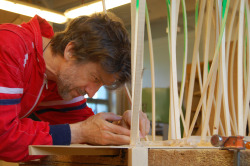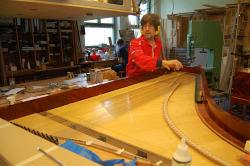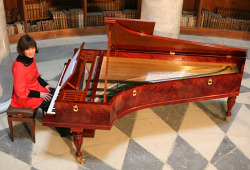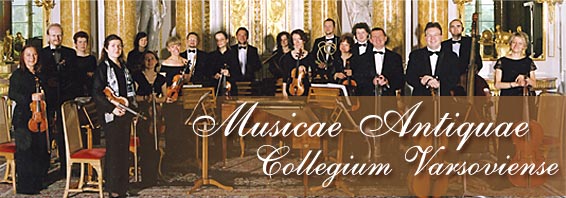![]()
"COMPLITELY DIFFERENT PERSONALITY"
The talk with fortepiano maker Paul McNulty and pianist Viviana Sofronitsky about historical fortepianos and their copies.
Kacper Miklaszewski: How many copies of pianoforte from the end of the eighteenth century to today are on the concert podiums all over the world?

Paul McNulty in his workshop in Divisov
near Prague
Paul McNulty: One hundred fifty have left my workshop, and I suppose my colleagues have together contributed the same number.
How many copies of instruments from the time of Schumann, Chopin and Liszt?
Paul McNulty: One ...
What is the difference from the times of copying of Haydn's piano from the time of Chopin?
The Stein piano, from Haydn’s era, has its own sophistication, but recent years have brought access to technical skills-- casting, specialty carving, et al – needed for a more industrial product like a Pleyel, which were not available at any price in Amsterdam, for example, where I began my trade. The Czech republic has many great artisans, and the association with them has blossomed into shapely fluted legs with cast feet and rollers, among many other challenges.
Recent developments in organology gave us the opportunity to measure soundboard thicknesses, without knowing which a builder can only guess and flounder, perhaps never arriving at the same result that an experienced 18th century workshop developed over the course of building their many hundreds of pianos. I have had firsthand access to disassembled examples of the four models I build, where only one, Pleyel, has an open bottom. In Viennese pianos, until 1830, bottoms are closed, and it is only once the soundboard has been removed that the important acoustical details can be discovered. The better known builders of the proto-industrial period built 3 or 4 pianos per worker, per year. Training and experience may eventually bring us to the level of production which seems to have been expected in France or in Austria between 1780 and 1850.
How changing the thickness of the soundboard in different places?

Paul McNulty during his work
on his replica of Pleyel piano
Paul McNulty: The builder chooses the means to graduate stiffness in a soundboard – Walter used a soundboard of uniform thickness, but carved his ribs to an exquisite degree, which I copy religiously. Graf, on the other hand, has quite regular ribs, but thins the soundboard significantly toward the edges. Stein thins the entire treble area to the thickness of a lute soundboard, but Pleyel has the opposite formula, where the treble is twice the thickness of the bass. These seemingly arbitrary differences come about in creating the speaking and singing characteristics of a piano design. It is the job of the soundboard to radiate the energy either slowly or quickly. A thick soundboard resists movement, but, once being made to move, resists dissipating the energy it carries. A big bell does the same. In the same way that one would not ring a church bell with a soup spoon, one does not begin a formal toast by tapping a champagne glass with a large clapper. Note that the champagne glass has a projecting, sweet, short and pure-sounding ring, while the church bell has a loud, complicated, long-sustaining and noble tone. In identical fashion, piano soundboards are designed to speak in different ways, to be activated with suitable percussion devices. These variables are fascinating to observe and to recreate, and serve to teach one the various narrow paths to acoustic satisfaction.
Building a copy of a Pleyel piano was more difficult, because it was my first experience working with iron and oak. The Viennese builders I copy used spruce frames and a single short iron brace. Pleyel and other instruments of the 1830s were built with oak, and utilized iron bars above and below the soundboard. The Pleyel is put together using 20mm oak boards; some of these form the outer case, stiffened with 2mm oak facings glued across the grain, then veneered with ornate mahogany; the main inner structures are 60mm thick, comprising three oak boards glued together, and the inner bentside of the piano is formed of 3 steamed 20mm oak boards, clamped together with massive force onto a curved form. The iron bars require being cast, and in this process one makes a wooden example one % larger in all dimensions, to allow for shrinkage as the cast iron cools. It was interesting to find Pleyel conveniently using metric dimensions, thanks to Napoleon.
Does every employee Pleyel company was preparing a separate part, while others assembled a whole, or small work teams of master craftsmen responsible for the construction from start to finish?
Paul McNulty: Production was divided into small sections between groups of people, as in a modern factory. In pianos, one finds signatures of different workers on the important components.
Which material were you using for the strings?
Paul McNulty: Iron wrapped with brass for the bottom eight notes, plain brass for another octave, then iron all the way to the top. The iron itself is thankfully these days made with reference to historical wire, where the carbon content is very low, and a small amount of phosphor helps. Without the phosphor, iron with almost no carbon simply stretches like taffee.
Are there still today instruments with original historical instrument strings?
Paul McNulty: Many of them have original strings to some degree. It rare to find original hammers on a French piano of the 1830s. Hammers were typically recovered at some period in the piano’s working life, urged on by the growing use of felt in this period. Felt came into use as early as the twenties, but its adoption was gradual. My Pleyel example was said to have been leathered, although this piano doesn’t have its original hammer assembly. I studied Hummel’s 1830 Erard, now in the Hummel Museum in Bratislava. This action is completely original, the hammers all of leather.

Viviana Sofronitsky at the copy
of Pleyel fortepiano
Viviana Sofronitsky: The leather itself is another item. You might think that, like steel, the difference in leather is that it can be clean or distorted, or come from this or another animal, end of story. Not at all– even the same animals 200 years ago had different skin! Many generations of sheep were subjected to selection and breeding so that new breeds were obtained, which have much more fleece than the same animals in the time of Mozart. Modern hides are so different and difficult to judge.
Paul McNulty: We have participated in a project of the Vienna Kunsthistorischesmuseum, in which ancient recipes and techniques of tanning were employed. I acquired 20 sheepskins. In the modern process of tanning collagen is removed from the skin, and the elasticity, or bounce, is gone. The skins we have tanned according to old processes are palpably bouncy, though not actually as supple as one wants for the piece contacting the string. For this reason we used our bouncy old sheep leather for some of the inner layers of the hammers, with another chamois-type skin for the outer layer, as was done from the 1820s in Vienna and Paris. This leather was provided by an Austrian, from a family tanning since the mid-nineteenth century, himself completing his studies in tanning at Vienna University. He uses mountain animals and tans with oil. I can prepare ten hammers per day, then try them in the instrument and – who knows? If the result is good, ten are usable, and ten more will follow tomorrow; otherwise, I take them off and try again.
Is the demand for copies of similar pianos growing? Now celebrating the anniversary of Chopin and Schumann, next year will turn to Liszt ...
Paul McNulty: Our copy is surprisingly unlike the Pleyel antiques I’ve heard, not for want of accuracy in reproducing dimensions and materials, I believe, but because the piano is new. I'm glad, because I was afraid – these antiques can sound frightful. I am encouraged to have found the Pleyel not so difficult to build - straightforward, just big and heavy. If I did not have other orders, I could make five copies of Pleyel per year. It is difficult to expect a concert institution to order such a piano, as well they should, but more and more universities are opening their doors to historical performance and want to have original instruments. It was the same with harpsichords: they came back slowly, but now every school has one.
Viviana Sofronitsky: Historical instruments, even their modern copies, are very different from one another. Thus - like a violin - some appear to be “close in spirit” to one musician, and another might appeal to a different player. Fortepiano players often travel with their own instruments, and their instruments become their “partners” in the same way as with violins and their owners. This is far from the relative uniformity of the modern piano concert situation, where most pianists are playing every day on a different piano in a different city. In theory, one can travel with a fortepiano as with a cello; however, loading the fortepiano in the car takes a certain effort, and there’s more to follow at the venue –steps, stairs, doors to open, questions of humidity . But we rejoice at every listener who comes after the concert so enthusiastic over such a wealth of unexpected colors, often admitting that they’d never imagined this or that piece of music could be so interesting. Many pieces begin a new life after they are played on the appropriate instrument. Paul’s art is close to the art of music. While all materials, dimensions and proportions are most important, ultimately it all comes down to assessing the ability to create many colors and dynamic degrees. The heart dictates the answer when the instrument interacts with the music intended for it.
Catherine Drogosz, Polish pianist specializing in playing the old instruments once told us that the transition from instrument from the late eighteenth century to the fortepiano the mid-nineteenth century might be very difficult for the same musician in one concert
Paul McNulty: Yes, the differences are greater than we expect. When the Stein key is pressed down 4 millimeters, the hammer rises 40 mm =10:1 ratio. In the modern piano, the key travels 10mm, the hammer 48mm, so this ratio is less than 5:1 . In Graf and Walter, the ratio is about 7:1. What this means for the Stein is a touch that gives the player the impression of mass, even though the hammer is extremely light, and a dynamic response based on speed. In this piano, greater hammer mass wouldn’t develop more sound, but rather dampen with inertia the speech of the strings and the ultra-thin soundboard. When building a Stein, a few upper notes in an unfinished instrument might be dull and percussive; however, this is easily corrected by trimming the hammer a bit lighter. The modern piano creates its dynamic and sustain in similar proportion to its own elements.
Viviana Sofronitsky: I agree with Kate that it is difficult to switch, but in my practical life I am trying to overcome these difficulties, performing on different pianos in the same concert because of the advantages this gives to the whole presentation. Listeners hear for themselves the connection between the instruments and the music. It might be a risk to change quickly between - say - music of Scriabin on a Bechstein and the works of Mozart on a Walter, but I feel I can adapt my hands with good results up to the keyboards of the 1830. Sometimes in concert I play the same musical excerpt on different pianos –it helps listeners to realize how much depends on the instrument. Our Pleyel keyboard is not as heavy as the modern action. Not only is it lighter – it creates tone in a completely different way, giving a different personality to the expression.
